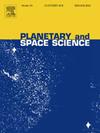彗星12P/庞斯-布鲁克斯:尘埃属性
IF 1.7
4区 物理与天体物理
Q3 ASTRONOMY & ASTROPHYSICS
引用次数: 0
摘要
12P/庞斯-布鲁克斯彗星是一颗轨道周期为71年的哈雷彗星,于1812年首次被发现。它遵循一个高度倾斜的轨道,起源于海王星的轨道之外。地面观测表明,这颗彗星在接近太阳的过程中,在距太阳11天文单位的日心距离处表现出活动。从那以后,许多研究都集中在它的行为上,特别是它在近日点前的爆发,这为它的动态和不稳定的本质提供了有价值的见解。这项研究考察了12P经过近日点后的尘埃行为。利用位于Astronómico El Leoncito (CASLEO)的0.6米Helen Sawyer Hogg望远镜,在2024年5月至6月期间使用宽带I, R和V滤波器捕获了一系列图像。形态学、光度学和数值分析研究了这颗彗星的尘埃特征。增强成像显示,在一个各向同性的彗发中有两个活跃区域,这导致了它独特的“魔鬼彗星”外观。光度分析,根据A(0°)fρ参数的星等和尘埃产生率,表明普通的尘埃行为,没有观察到特征爆发。为了进一步了解12P的尘埃行为,这些数据被用于研究彗星尘埃的新理论模型。该模型表明,尘埃昏迷主要由两个高纬度活动区域以大约409ms−1的速度发射的大颗粒组成,假设旋转周期为57 h。本文章由计算机程序翻译,如有差异,请以英文原文为准。
Comet 12P/Pons-Brooks: Dust properties
Comet 12P/Pons-Brooks, a Halley-type comet with a 71-year orbital period, was first discovered in 1812. It follows a highly inclined trajectory, originating from just beyond Neptune’s orbit. Ground-based observations have shown that the comet exhibited activity at a heliocentric distance of 11 au during its approach to the Sun. Numerous studies have since focused on its behavior, particularly its pre-perihelion outbursts, which have provided valuable insights into its dynamic and volatile nature.
This study examines the dust behavior of 12P following its perihelion passage. Using the 0.6 m Helen Sawyer Hogg telescope at the Complejo Astronómico El Leoncito (CASLEO), a series of images were captured between May and June 2024 using broadband I, R, and V filters. Morphological, photometric, and numerical analyses were performed to investigate the comet’s dust characteristics. Enhanced imaging revealed two active regions within an isotropic coma, which contributed to its distinctive “devil comet” appearance. Photometric analysis, based on the magnitudes and dust production rate from the parameter, indicated ordinary dust behavior, with no characteristic outbursts observed.
To gain further insights into 12P’s dust behavior, the data were fitted to a new theoretical model for studying dust in comets. This model suggests that the dust coma primarily consisted of large particles emitted from two high-latitude active areas at a velocity of approximately , assuming a rotation period of 57 h.
求助全文
通过发布文献求助,成功后即可免费获取论文全文。
去求助
来源期刊

Planetary and Space Science
地学天文-天文与天体物理
CiteScore
5.40
自引率
4.20%
发文量
126
审稿时长
15 weeks
期刊介绍:
Planetary and Space Science publishes original articles as well as short communications (letters). Ground-based and space-borne instrumentation and laboratory simulation of solar system processes are included. The following fields of planetary and solar system research are covered:
• Celestial mechanics, including dynamical evolution of the solar system, gravitational captures and resonances, relativistic effects, tracking and dynamics
• Cosmochemistry and origin, including all aspects of the formation and initial physical and chemical evolution of the solar system
• Terrestrial planets and satellites, including the physics of the interiors, geology and morphology of the surfaces, tectonics, mineralogy and dating
• Outer planets and satellites, including formation and evolution, remote sensing at all wavelengths and in situ measurements
• Planetary atmospheres, including formation and evolution, circulation and meteorology, boundary layers, remote sensing and laboratory simulation
• Planetary magnetospheres and ionospheres, including origin of magnetic fields, magnetospheric plasma and radiation belts, and their interaction with the sun, the solar wind and satellites
• Small bodies, dust and rings, including asteroids, comets and zodiacal light and their interaction with the solar radiation and the solar wind
• Exobiology, including origin of life, detection of planetary ecosystems and pre-biological phenomena in the solar system and laboratory simulations
• Extrasolar systems, including the detection and/or the detectability of exoplanets and planetary systems, their formation and evolution, the physical and chemical properties of the exoplanets
• History of planetary and space research
 求助内容:
求助内容: 应助结果提醒方式:
应助结果提醒方式:


